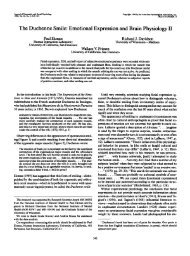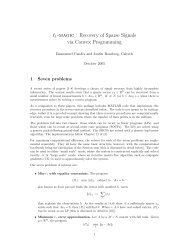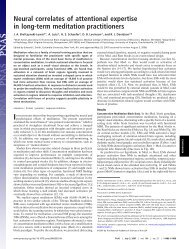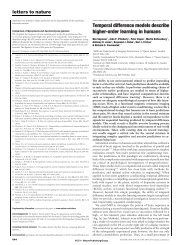where df B is the number <strong>of</strong> degrees <strong>of</strong> freedom for the baseline model, and df F is thenumber <strong>of</strong> degrees <strong>of</strong> freedom for the full model. Specically, we have (assuming that thenoise model contains the two parameters for constant plus linear trend):df B = N 0 ; 2df F = N 0 ; 2 ; (p +1)so df B ; df F = p +1:where N 0 = N ; p is the number <strong>of</strong> usable data points.By the above reasoning, we see that a large value for F indicates that signal is present,whereas a small value for F suggests that only noise is present. The statistic F has theF (df B ; df F df F ) distribution under the null hypothesis (Ref. [2]).Program 3dDeconvolve calculates the F statistic for each voxel, and (if the -fout optionis used) appends these values as one <strong>of</strong> the sub-bricks <strong>of</strong> an AFNI \bucket" dataset.1.2.6 Coecient <strong>of</strong> Multiple DeterminationThe coecient <strong>of</strong>multiple determination, R 2 , can be used as an indicator for how well thefull model ts the data. We dene R 2 :R 2 1 ; SSE(F )SSE(B)where SSE(F ) and SSE(B) are dened above. Roughly speaking, R 2 is the proportion<strong>of</strong> the variation in the data (about the baseline) that is explained by the full regressionmodel. Note that, for every voxel, 0 R 2 1. (R 2 is a generalization <strong>of</strong> the square <strong>of</strong> thecorrelation coecient computed in the m programs).Program 3dDeconvolve calculates R 2 for each voxel, and (if the -rout option is used)appends these values as one <strong>of</strong> the sub-bricks <strong>of</strong> an AFNI \bucket" dataset.1.2.7 t-test for Signicance <strong>of</strong> Individual ParametersWhen comparing dierent impulse response functions, it is useful to know the signicance<strong>of</strong> the individual terms that constitute the impulse response function. This may help in decidingwhether dierent impulse response functions are truly dierent, or merely reect theinuence <strong>of</strong> measurement noise. Therefore, program 3dDeconvolve provides the t-statisticsfor the individual terms in the impulse response function.For the linear regression model, the variance-covariance matrix for the regression coef-cients is given by:s 2 (b) =MSE ; X t X ;1Then, for large sample size N, dene the statistic t :t [h k ]=h ks(h k )12
where s(h k ) is the square root <strong>of</strong> the corresponding diagonal element <strong>of</strong> the s 2 (b) matrix.Under the null hypothesis, t has the t(N 0 ; p ; 3) = t(N ; 2p ; 3) distribution (Ref. [2]).Program 3dDeconvolve calculates the t statistic for each point in the impulse responsefunction, at each voxel location, and (if the -tout option is used) appends these valuesas sub-bricks <strong>of</strong> an AFNI \bucket" dataset for each parameter. Also, if requested bythe user (see option -sresp), program 3dDeconvolve saves the array <strong>of</strong> standard deviationsfs(h k )k =0 ::: pg for each voxel into an AFNI 3d+time dataset. In this case, the datasettime series has length p +1.As mentioned above, the sample standard deviation s(h k ) <strong>of</strong> the estimate for parameterh k is obtained as the square root <strong>of</strong> the corresponding diagonal element <strong>of</strong>thes 2 (b) matrix.The s 2 (b) matrix is calculated by multiplying the scalar MSE (the mean square error,which estimates the measurement error variance) by the matrix (X t X) ;1 . Now, assumingthat the measurement error variance is a constant (for agiven voxel), we see that s 2 (b) isa function <strong>of</strong> X alone. In other words, the accuracy <strong>of</strong> the estimate for parameter h k isdetermined by the structure <strong>of</strong> the experimental design matrix X. But the structure <strong>of</strong> X isdetermined by the input stimulus function(s) f(t). Therefore, we see that the experimentaldesign directly inuences the accuracy <strong>of</strong> the parameter estimates.The signicance <strong>of</strong> this is: we can numerically evaluate the relative accuracy <strong>of</strong> dierenthypothetical experimental designs prior to collecting data. Knowing the input stimulusfunction(s) f(t), the matrix X can be assembled, and (X t X) ;1 computed. Setting theunknown scalar MSE to 1, the normalized standard deviation s(h k ) can be calculated,as described above. This procedure can be repeated for dierent hypothetical stimulusfunctions, thus allowing a comparison <strong>of</strong> alternative experimental designs prior to datacollection. See the Examples in Section 1.4.1.1.2.8 Multiple Linear RegressionThus far, we have considered only a single input stimulus function. However, the extensionto multiple input stimuli is straightforward. Suppose that the system response y(t) is alinear combination <strong>of</strong> the responses to input stimuli u(t), v(t), and w(t):y(t) = u u(t)+ v v(t)+ w w(t)Then the measured response, including linear drift and additive noise, and with the measurementsoccurring at discrete times n, is given by:Z n = 0 + 1 n + u u n + v v n + w w n + " nwhere "(t) iid N(0 2 ). This assumes zero time delay between the input stimulus andthe measured response. However, there may be some time delay, and the amount <strong>of</strong> timedelay may be dierent for dierent voxels. We will use the same approach as was used inestimating the impulse response function, i.e., the output will be modeled by the sum <strong>of</strong>lagged versions <strong>of</strong> the input functions. For example, if we consider time lags <strong>of</strong> 0, 1, and 2time units for each <strong>of</strong> the input stimuli, then the measured response canbemodeledthus:Z n = 0 + 1 n + u0 u n + u1 u n;1 + u2 u n;2+ v0 v n + v1 v n;1 + v2 v n;2+ w0 w n + w1 w n;1 + w2 w n;2 + " n13
- Page 1: Deconvolution Analysis of FMRI Time
- Page 7 and 8: Since the system is linear, the ope
- Page 9: the above equation can be written:Z
- Page 15 and 16: Here, SSE(F )isthe error sum of squ
- Page 17 and 18: concatenated runs, this is not the
- Page 19: This equation relates the output y
- Page 22 and 23: value is pnum = 1 (corresponding to
- Page 24 and 25: model parameters, and P columns, ea
- Page 26 and 27: Program 3dDeconvolve Command Line f
- Page 28 and 29: f(t) = f 0 0 1 1 1 0 1 1 0 0 1 0 1
- Page 30 and 31: If we model the measured response b
- Page 32 and 33: Note that, since there is only one
- Page 34 and 35: Full Model:MSE = 0.9618R^2 = 0.9835
- Page 36 and 37: that are not of inherent interest,
- Page 38 and 39: Program 3dDeconvolve Command Line f
- Page 40 and 41: Now, model the measured data as a c
- Page 42 and 43: -stim label 1 Random -stim label 2
- Page 44 and 45: Note: This example is for illustrat
- Page 46 and 47: The output is the same as for Examp
- Page 48 and 49: After program 3dDeconvolve has nish
- Page 50 and 51: Program 3dDeconvolve Command Line f
- Page 52 and 53: Program:3dDeconvolveAuthor:B. Dougl
- Page 54 and 55: cat y.1D y.1D > ycat.1DBe sure to r
- Page 56 and 57: Recall that in Example 1.4.4.6, we
- Page 58 and 59: and the noisy measurement data:wp(t
- Page 60 and 61:
The model that we will use for the
- Page 62 and 63:
Program 3dConvolve Command Line for
- Page 64 and 65:
2 Program plug deconvolve2.1 Purpos
- Page 66 and 67:
voxels indicated by the crosshairs,
- Page 68 and 69:
Deconvolution Plugin Screen Output
- Page 70 and 71:
The following Random Permutation an
- Page 72 and 73:
Shuffled array:0 5 6 1 3 5 0 2 1 1
- Page 74 and 75:
Program RSFgen Command Line for Exa
- Page 76 and 77:
Example 3.3.3.1 Initial Random Bloc
- Page 78 and 79:
Compare the output for this example
- Page 80 and 81:
Markov chain time series:0 0 1 5 0
- Page 82 and 83:
(X'X) inverse matrix::065 ;:000 ;:0
- Page 84 and 85:
Program 3dDeconvolve Screen Output
- Page 86 and 87:
then the standard deviation for the
- Page 88 and 89:
4 Program 3dConvolve4.1 PurposeAs t
- Page 90 and 91:
-input1DThe -input1D command specie
- Page 92 and 93:
-stim minlag k m-stim maxlag k n-st
- Page 94 and 95:
parameters b 0 and b 1 , and impuls
- Page 96 and 97:
Program 3dConvolve Command Line for
- Page 98 and 99:
Example 4.4.6 Single Stimulus No No
- Page 100:
5 References[1 ]F.Stremler, Fourier




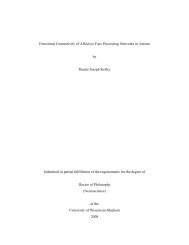
![[F-18]-L-DOPA PET scan shows loss of dopaminergic neurons](https://img.yumpu.com/41721684/1/190x146/f-18-l-dopa-pet-scan-shows-loss-of-dopaminergic-neurons.jpg?quality=85)
